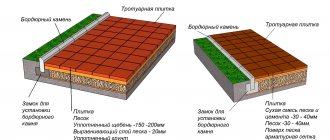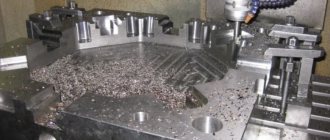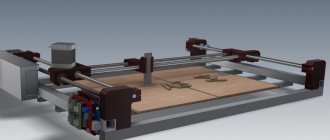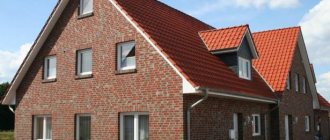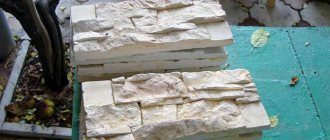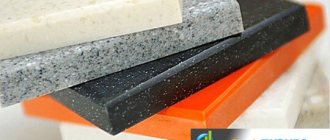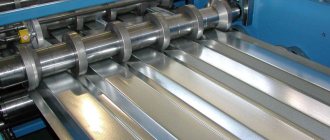Composition of cement-sand mixture and technology of vibrocompression of paving slabs
The technology of vibrocompression of paving slabs is the small-piece production of concrete components for pavements and platforms from a semi-dry mixture using the molding method (vibratory shrinkage of the composition with further compaction under a special press). Schematically, vibrocompression is a sequential cycle of work:
- feeding semi-dry concrete into a matrix (mold) installed on a vibrating table;
- compaction of the mixture in the matrix with a punch (moving-pressing part of the matrix);
- parallel vibration of the table, squeezing air bubbles out of concrete;
- removing the pressed product onto a tray for complete drying.
The technology allows automation of most technological processes. It should also be noted that intermediate work processes also play a significant role in the production cycle - preparation of raw materials and production of the mixture in a mortar-concrete unit, cleaning and preparation of forms, accurate calculation of punch pressure, as well as stripping, drying and moisture treatment of finished products.
Each batch undergoes sampling (quality control), after which the transport package is formed, tied, labeled and stored before sending the finished product to customer construction sites.
Advantages of vibration compaction
The obvious “advantages” of producing vibropressed paving slabs are well known:
- automation and high speed of production processes;
- mass production of products with uniform quality and technical characteristics;
- increased strength and wear resistance of products;
- the ability to produce tiles with a colored front layer and a reinforced coating of granite and marble chips.
The products receive a stable, strict shape and clear geometry. The surface of the tile does not crack, lends itself well to grinding, polishing, bush hammering, and the color coating is extremely stable and retains its brightness and saturation for up to 25 years of use of the tile.
Vibro-pressed tiles are cheaper than vibro-cast tiles, have a rough surface, can withstand much greater loads and are more effective when paving sidewalks, technical sites, urban areas, warehouses at freight terminals, and transport stops.
Features of the process of vibrocompression of paving slabs
When creating a cement-sand mixture for vibratory pressing of paving slabs per 1 cubic meter of mixture, the following is used:
- high-quality Portland cement according to GOST 31108-2003 (I 42.5H) – up to 590 kg;
- Mkr sand - up to 1640 kg;
- water - 180±5 liters.
The concrete mixture has a minimum water content (7-11%) and is considered heavy (from 2000 kg/m3), remains quite dry and plastic. This allows you to significantly save on cement consumption and obtain high-density products that can withstand loads of up to 30-50 MPa (low abrasion) and at least 200 freezing/thawing cycles (minimum water absorption + B200).
- The volume of filling the finished mixture into the molds is regulated by level sensors depending on the swing of the box feeder and the duration of the vibration cycle (on average in a bunker - 0.1-0.43 m3).
- The compaction, depending on the composition of the mixture, is regulated by unbalanced shafts (oscillation frequency - up to 3000 revolutions).
- Pressure of raw material pressing by punches is not less than 0.2 MPa. This is sufficient for moving and stacking molded tiles.
The finished tiles are unloaded onto pallets and undergo a two-level heat-moisture (steam) treatment in TVO floor chambers: 5-8 hours at +20°C, then 8-9 hours at +50+55°C. An initial holding time of 1 hour is required, and once peak heating is reached, the temperature is gradually lowered.
Next, the finished tiles are packaged and tied on pallets, undergo technical control and transported to the warehouse.
Source
Advantages and disadvantages
Advantages of vibropressed paving slabs:
- high strength indicators;
- frost resistance;
- the ability to create various configurations;
- ease of repair and installation;
- non-porous, glossy surface.
Flaws:
- the difficulty of selecting exact proportions for the solution;
- high cost of equipment for large-scale production;
- slippery surface.
Vibration-pressed paving slabs have gained popularity due to the low costs of small-scale production. Suitable for laying garden paths and creating individual designs.
Compositions of concrete for the production of blocks using semi-dry vibrocompression:
Heavy concrete:
Lightweight concrete:
In the production of wall blocks, three main components are used: binder, aggregate and water. Cement and slow-hardening gypsum can be used as a binder, and sand, crushed stone screenings, expanded clay, slag, ash, sawdust, or any similar local materials capable of creating a durable composition after mixing with the binder and setting it, can be used as a filler. For the manufacture of construction products, all types of cements with a strength grade from 200 to 600 kg/cm can be used.
When using a cement-based mixture, the finished products are aged from one (at a temperature of +15. +45 degrees C) to two (at a temperature of +5. +10 degrees C) days, after which they acquire strength sufficient for storage and transportation. 100% of the strength of the product is acquired after 28 days at a aging temperature of 20 degrees C. If the consumer has a steaming chamber, the products can be subjected to heat treatment for 6.8 hours at a temperature of at least + 50.75 degrees C. In this case, after cooling and drying they acquire 60.80% brand strength.
The selection of the compositions given below was carried out using Portland cement grade 400 (PTs M400). Data for 1 cubic meter of mixture. When using grade 300 cement, cement consumption should be increased by 15%. If it is necessary to increase the strength of products by 10 kg/cm (for example, from grade 30 to grade 40), the consumption of cement in concrete should be increased by 10..15%.
Mixture recipes for vibrocompression
Euro-made products - only the best home-made products of the RuNet! How to make it yourself, master classes, photos, drawings, instructions, books, videos.
Compositions for the manufacture of products by vibration pressing
Options for preparing a solution for pressing per 1 m3 of mixture:
— In the “Number of components” column, the volume of filler in m3 is indicated before the brackets, and its weight in kg is indicated in brackets. Depending on specific local conditions (field, production method, etc.), the density of aggregates may differ from the average densities used in the compositions. In this case, the composition must be adjusted experimentally.
— In the column “Density of concrete” its density is indicated in kg/cubic meter. m. The column “Grade of concrete and solid products” indicates the brand (strength) of concrete or the brand of any solid products made from this concrete (brick stones, plinths, curbs, etc.) in kg/cm 2 .
— In the column “Brand of hollow stone” the brand in kg/cm2 of hollow wall stones measuring 390x190x188 mm and hollow partition stones is indicated. The strength of these products is lower than the strength of concrete due to the presence of voids.
— In sawdust concrete compositions it is allowed to use any sawdust untouched by rot, however, softwood sawdust is preferable to hardwood sawdust because swell less. To improve the preservation of sawdust in concrete, it is advisable to introduce the Proston D-18 accelerator into the compositions in an amount of up to 2% by weight of cement.
— Of the indicated compositions, concrete with a minimum density has the best thermal insulation properties: the “warmest” is concrete with a density of 880 kg/cu. m, the “coldest” - with a density of 2300 kg / cubic meter. m.
Cement-based compositions:
HEAVY CONCRETE
Concrete density kg/m3
Grade of concrete and solid block kg/cm2
Brand of hollow block kg/cm2
Concrete on sand and crushed stone.
Cement, kg Sand quartz m3 (kg) Water, l.
240 1,15 (1950) 90…130
Cement, kg Sand quartz. M3 (kg) Dolomite or limestone crushed stone, m3 (kg) Water, l
200 0,54 (920) 0,65 (980)
Cement, kg Dolomite or limestone screenings, m3 (kg) Dolomite or limestone crushed stone, m3 (kg) Water, l
200 0,3 (450) 0,8 (1200) 90…130
Cement, kg Dolomite or limestone screenings, m3 (kg) Water, l
Cement, kg Quartz sand, m3 (kg) Granite crushed stone, m3 (kg) Water, l
200 0,54 (920) 0,65 (1100) 90…130
Concrete on brick waste
Cement, kg Clay waste. Or silica. Brick fraction. 2…15 mm, m3 (kg) Quartz sand, m (kg) Water, l
230 0,9 (990) 0,32 (540) 90…130
LIGHTWEIGHT CONCRETE
Expanded clay concrete
Cement, kg Expanded clay, m3 (kg) Water, l
250 1,2 (720) 100. 150
Cement, kg Expanded clay fraction. 0.5 mm, m3 (kg) Expanded clay fraction. 5. 15 mm, m3 (kg) Water, l
220 0,65 (390) 0,6 (330) 90. 130
Ash concrete
Cement, kg Coal ash. or slate, m3 (kg) Water, l
200 1,2 (960) 90. 130
Cement, kg Coal ash or oil shale. m3 (kg) Quartz sand, m3 (kg) Water, l
220 0,9 (720) 0,32 (540) 90. 130
Cement, kg Crushed dolomite or limestone, m3 (kg) Coal ash. or slate, m3 (kg) Water, l ¦ 9O. 13O
200 0,5 (750) 0,53 (420) 90. 130
Expanded clay concrete
Cement, kg Expanded clay fraction. O. 5 mm, m3 (kg) Expanded clay fraction. 5. 15 mm, m3 (kg) Coal ash. or slate. m3 (kg) Water, l
200 0,65 (390) 0,55 (300) 0,44 (350) 90. 130
Cinder concrete
Cement, kg Granulated slag, m3 (kg) Water, l
200 1,3 (720) 90. 130
Cement, kg Granulated slag, m3 (kg) Quartz sand, m3 (kg) Water, l
200 0,9 (500) 0,32 (540) 90. 130
Cement, kg Boiler slag, m3 (kg) Water, l
200 1,2 (1080) 90. 130
Cinder concrete
Cement, kg Boiler slag, m3 (kg) Quartz sand, m3 (kg) Water, l
200 0,8 (720) 0,32 (540) 90. 130
Ash and slag concrete
Cement, kg Boiler slag, m3 (kg) Coal ash. or shale, m3 (kg) Water, l
200 0,8 (720) 0,4 (720) 90. 130
Sawdust concrete
Cement, kg Sawdust, m3 (kg) Quartz sand, m3 (kg) Water, l
260 0,6 (150) 0,65 (1100) 100. 150
Cement, kg Sawdust, m3 (kg) Quartz sand, m3 (kg) Water, l
280 0,4 (100) 0,8 (1350) 100. 150
Cement, kg Sawdust, m3 (kg) Quartz sand, m3 (kg) Lime paste, m3 (kg) Water, l
230 0,9 (220) 0,3 (500) 0,04 (50) 100. 150
Expanded clay sawdust concrete
Cement, kg Cramsite, m3 (kg) Sawdust, m3 (kg) Water, l
280 0,7 (420) 0,6 (150) 100. 150
How to make concrete solution
To prevent the solution from staining the surface of the area (asphalt, concrete, other tiles), you need to use polyethylene, a large container or other available devices. You can mix the components in different ways. Options available for making your own concrete:
- combine the dry ingredients in one container, add water (in small portions) until the solution reaches the desired consistency;
- prepare cement laitance: pour water, add cement, then combine the resulting solution with sand and crushed stone;
- First, dry solid fraction components (crushed stone, sand) are mixed, cement mortar is prepared separately, and then the mixtures are combined in one container.
INTERESTING: Soldering (welding) of polypropylene pipes: what you need to know and how to avoid mistakes
A concrete mixer is used if it is necessary to immediately produce a large amount of paving slabs. Instructions for making concrete in this case:
- The concrete mixer turns on.
- While the drum is rotating, water is poured.
- Cement is poured in dry form.
- When laitance appears, the remaining components are added.
Composition of concrete for paving slabs - main components and manufacturing details
The problem of road paving has faced people of all eras. Changes of seasons, rains and sub-zero temperatures quickly rendered any coating unusable. Natural stone remains the most resistant to weather changes, but its use requires significant investment and does not guarantee an ideal road surface.
Artificial stone allows you to get not only a durable, but also a very attractive coating, which is why concrete paving elements are in great demand. The composition of concrete for paving slabs determines not only the operational features of the products, but also the aesthetics of the future coating. Concrete sidewalks are in demand both in the design of city streets and in private areas.
Vibro-pressed or vibro-cast paving slabs - which one to choose?
When choosing paving slabs, the consumer first of all pays attention to the performance characteristics, appearance of the paving stones, and the final cost per square meter of the road surface.
It turned out that vibro-pressed tiles are ahead of vibro-cast tiles in all respects, except cost.
- The technical characteristics (frost resistance, strength, overall service life) of vibropressed tiles are significantly higher than those of a similar model made by hand.
- The performance characteristics (wear resistance, durability, abrasion resistance) of pressed tiles significantly exceed those of cast tiles, which makes it possible to use vibropressed paving stones even for designing roads for passenger vehicles.
- The roughness of the outer surface is a significant advantage of vibration-pressed tiles in terms of safety for pedestrians in rain and winter.
Statistics on roadway repairs show that a road made of vibropressed tiles will require at least 25 years to complete its first repair, while for a cast tile the repair period is 5-10 years. Moreover, only 20-30% of pressed road elements will require replacement, while for cast products this figure reaches 70-80%.
If we consider the cost of the roadway as the main criterion for choosing the type of tile, then vibrocast tiles are much cheaper, since the cost of a unit of production includes overhead costs for the purchase and operation of automation.
Basic properties and production methods
Concrete paving slabs, like any other paving element, must comply with the requirements of GOST 17608-91. According to the standard, all types of products must:
- made of heavy or fine-grained concrete;
- have a strength class of B22.5;
- have a tensile strength in bending of at least 3.2 MPa;
- have frost resistance of at least F100 and water absorption of no more than 6%.
In addition, in the production of paving slabs, technologies are used that make it possible to produce products in one or two layers, with or without the use of pigment.
Composition requirements
Cement should not contain mineral additives exceeding 5%, as well as tricalcium aluminate exceeding 8%. The water-cement ratio cannot exceed 0.4, and the amount of air in the mixture should be within 4 - 5%. To ensure high frost resistance, special additives with an air-entraining effect are introduced into the concrete mixture.
Such requirements leave a significant imprint on the composition of artificial stone. The recipe for concrete for paving slabs largely depends on the production technology and materials used. Thus, the main methods of manufacturing paving elements are vibration pressing and vibration casting.
Performance comparison
Many buyers are interested in which paving slabs are better. The answer depends on the area in which the slabs will be used. If a large load will be placed on the coating, you need to choose durable products with a long service life.
The performance characteristics of paving stones depend on what production technology was used. All slabs are made from the same raw materials, but the proportions of concrete are different. The time required to form products differs. The quality of coloring depends on the technology chosen.
Vibrocast tiles
Such slabs have a smooth surface. It is slippery, so manufacturing companies apply notches to the surface of products or make a figured ornament. The material is easy to cut with a stone disc and can be chipped with a pick. The service life of the slabs is 5-8 years, but much depends on the operating conditions.
The coating fades quickly. Tiles crack when impacted and often break when cleaning sidewalks in winter. The quality of the product depends on how strictly the manufacturer followed the technology. Therefore, it is better to buy products from large companies.
Vibropressed
Such slabs are more expensive than vibrocast slabs, but their performance is higher. Paving stones have stable dimensions, making them easier to work with. But the products are durable, so they are more difficult to process, chip and cut.
Tiles made by vibration pressing have a rough front side. It is more convenient for pedestrians to move along it.
The paving stones are laid on a flat, compacted base. Quartz or river sand is used to fill the joints.
Hyper-pressed
Hyperpressed tiles are more expensive than other products, but they last a long time even in difficult conditions. The slabs have an attractive design and are durable, although thinner. It is comfortable for pedestrians to walk on such paving stones; shoes do not slip even in winter.
The only drawback is that such slabs are difficult to lay on radius sections and on a winding surface. The declared high characteristics will only be available for those products that were produced by enterprises that strictly adhere to the technology.
Specifics of pressing with simultaneous vibration
The most common method in the industrial production of paving slabs is vibropressing. This technology makes it possible to obtain a significant volume of production per work shift, but requires extensive experience of workers and the operator responsible for the production of the concrete mixture.
Features of the recipe
The recipe for artificial stone for vibrocompression is characterized by the absence of inert aggregates with a particle size of more than 5 mm. The technology involves compaction by pressing the mixture with simultaneous vibration, which affects the requirements for water content.
The composite for vibrocompression must be homogeneous, but rigid to prevent delamination during compaction.
To create such a system, coarse aggregate is contraindicated, since it requires a larger amount of moving mortar part for uniform distribution.
That is why the proportions of cement, sand or screenings, water, pigments and additives differ significantly from the classic ones for heavy artificial stone. This material is called fine-grained concrete.
Basic proportions
The specifics of compaction of the mixture do not allow the production of such tiles at home, because it is very difficult to ensure the proper load with your own hands. Most often, the proportions of cement and fine aggregate are taken to be 1:3 or 1:4, respectively, and the amount of water does not exceed 30% of the mass of cement. To color products, mineral and organic pigments are used with a dosage ranging from 1 to 3% of the weight of cement.
Vibropressing is a modern method of producing paving stones
From the same raw materials (cement, sand, gravel, modifiers and water), modern factories produce paving slabs using the vibration pressing method. The method is very similar, but the use of automation allows you to put production on stream:
- Automation accurately doses the composition of the concrete mixture.
- The shaped forms are filled with a semi-dry composition - less water, shorter hardening time.
- Within a batch, all tiles are the same thickness.
- A vibropress compacts the concrete mixture under the combined influence of static and dynamic loads, which reduces the likelihood of cavities and other molding defects.
- Simple unmolding of blanks.
- It is possible to produce one- or two-layer products with higher strength characteristics.
- Flow production with minimal manual labor makes it possible to produce large quantities of goods.
There is a clear advantage of paving stones obtained by vibrocompression.
Vibration casting technology
This production method is not particularly productive, but allows the production of products with complex geometries and designs. Thanks to the use of a moving mixture and moderate compaction, the composite fills all the curves of the form, so a pattern of any complexity appears clearly and practically without flaws.
Composition of the solution
The composition of the mixture for paving slabs made by vibration casting is characterized by a large amount of filler, as well as the possibility of using crushed stone with a grain size of 3 - 10 or 5 - 20 mm. In this technology, it is important to achieve mobility of the mixture, so the recipe is distinguished by the presence of effective plasticizers and stabilizers.
In addition, when introducing crushed stone from dense rocks, such as granite, the amount of cement can be reduced, because the stone frame will ensure a dense and durable concrete structure.
In fact, the composition of the composite and the main proportions of raw materials in the production of paving slabs using vibratory casting technology are very close to the recipes for classic heavy concrete. If special forms are available, such products are easy to produce at home, and the mixture can be easily made with your own hands using a gravity mixer.
Selection of the basic ratio of components
When producing paving slabs on your own, it is best to move away from the classical scheme. So, if you increase the mobility of the mixture, you can reduce the intensity of vibration, which greatly simplifies the manufacture of products at home. With this approach, the composition of concrete should be slightly modified.
The main proportions of concrete used for pouring paving slabs can be represented in the following diagram:
- 1 mass part of cement;
- 1.5 – 1.7 parts by mass of sand;
- 2.5 – 3 mass parts of crushed stone;
- 0.35 – 0.4 parts by mass of water;
- plasticizer + pigment.
As the class of concrete increases, cement consumption increases proportionally and the proportions of aggregates decrease. As a result, the composition of the composite changes, but the artificial stone retains its dense structure and the entire set of properties.
How to check finished tiles for quality
It is almost impossible to visually determine whether the tile in front of you is of high quality or not. But there are some tricks that will help you choose more or less high-quality material:
- Tap it. If the sound is ringing, it means the tile density is high. Accordingly, the strength is at the proper level, the product is well dried.
- Bright color is a sign of a large number of added pigments. And they reduce the quality characteristics of the material.
- If the color on the cut is located only in the upper part of the product, then there is a high probability that the color will disappear or fade over time. The pigment should be evenly distributed throughout the entire body of the tile.
- The absence of bubbles and cracks is also a sign of quality.
- The presence of a certificate indicates that production is established in accordance with standards or technical conditions that are registered with government agencies.
This is what awaits you if you choose low-quality material
So, we discussed the topic of production and laying of paving slabs.
Comments for the site
Cackl e
Selection of materials
To create paving slabs with high strength, frost resistance and water resistance, it is important to select materials of appropriate quality.
Cement
The main element of any concrete is cement. For the manufacture of paving elements, you should choose medium-aluminate cements with a mineral additive content of no more than 5%, as well as with a strength class of 42.5. The packaging of such a binder indicates the grade CEM I 42.5 N or B. Medium aluminate cements include binders with a C3A content of 5 to 8%. You can find out the aluminate content from the seller by asking for the cement passport.
Fine aggregate
As a fine aggregate, it is best to use washed quarry sand with a particle size modulus of 2 - 2.5.
This material belongs to construction sands of the first class; when used, the concrete composition is characterized by lower consumption of binder and low cost with higher quality indicators.
Coarse aggregate
When using coarse aggregate, it is best to purchase granite crushed stone with a grain size of 3 – 10 mm. Such material will provide increased strength and durability with high mobility of the mixture. But its cost is high, so you can purchase a standard mixture of grains with a diameter of 5 - 20 mm and adjust the recipe, reducing the content of coarse aggregate.
This approach will ensure high mobility and uniformity during the formation of the stone frame in the body of the composite.
Self-production
The production of sidewalk elements with your own hands must begin with preparing a place for molding and storing products. Even with high mobility of the resulting mixture, after filling the molds, they must be compacted. Submersible or homemade vibrators are suitable.
Compaction should be carried out for no more than 5–10 s, otherwise the mixture will stratify and the appearance of the pavement elements will deteriorate.
Standard recipe
When producing a composite with strength class B25, you can use the following composition per 1 m3:
- cement = 390 – 420 kg;
- sand = 700 – 750 kg;
- crushed stone = 1000 – 1050 kg;
- water = 155 – 165 kg;
- plasticizer + pigment (if desired, color the products).
Mixing technology
When mixing the components, sand is first loaded, then water with additives and cement, and lastly crushed stone. Mixing is carried out for at least 2 - 3 minutes until a homogeneous material is obtained.
Paving slabs made of concrete of this composition will have intense hardening kinetics, so it is very important to prevent moisture loss from its surface.
Vibration casting as a method for producing paving slabs
A brief description of the entire technological production of paving stones using the vibratory casting method can be summarized as follows:
- In a closed mixer, a concrete mixture is prepared from sand, crushed stone, cement, plasticizers, water and pigment, if necessary.
- Elastic injection molds are placed on a special vibrating table, their inner surface is lubricated with machine oil.
- The finished mixture is manually poured into molds and the vibrating table is turned on for 5-10 minutes to compact the casting and free the material from bubbles.
- The workpieces are removed from the vibrating table and placed in a warm room, protected from direct rays, for 1 day to harden the composition.
- The finished products are removed from the molds - they can already be stored on pallets in normal warehouse conditions and even in the open air.
In this simple way, paving slabs of various configurations, shades, sizes and thicknesses are obtained.
Pros and cons of tiles produced by vibration casting
The main advantage of the technological process is its simplicity and economic feasibility of producing the product. The paving slabs themselves, produced by vibration casting, have a number of advantages among similar products on the paving materials market:
- The assortment is determined by the presence of various forms and additives of pigments of various shades.
- High strength characteristics and frost resistance of the casting due to the use of special additives.
- The smooth, glossy surface of the casting, without roughness or pores, makes this tile easy to keep clean.
- The lowest cost of vibrocast tiles among all types of paving stones.
- Simple laying technology and high maintainability - if necessary, a section of the sidewalk can be dismantled and then laid back.

